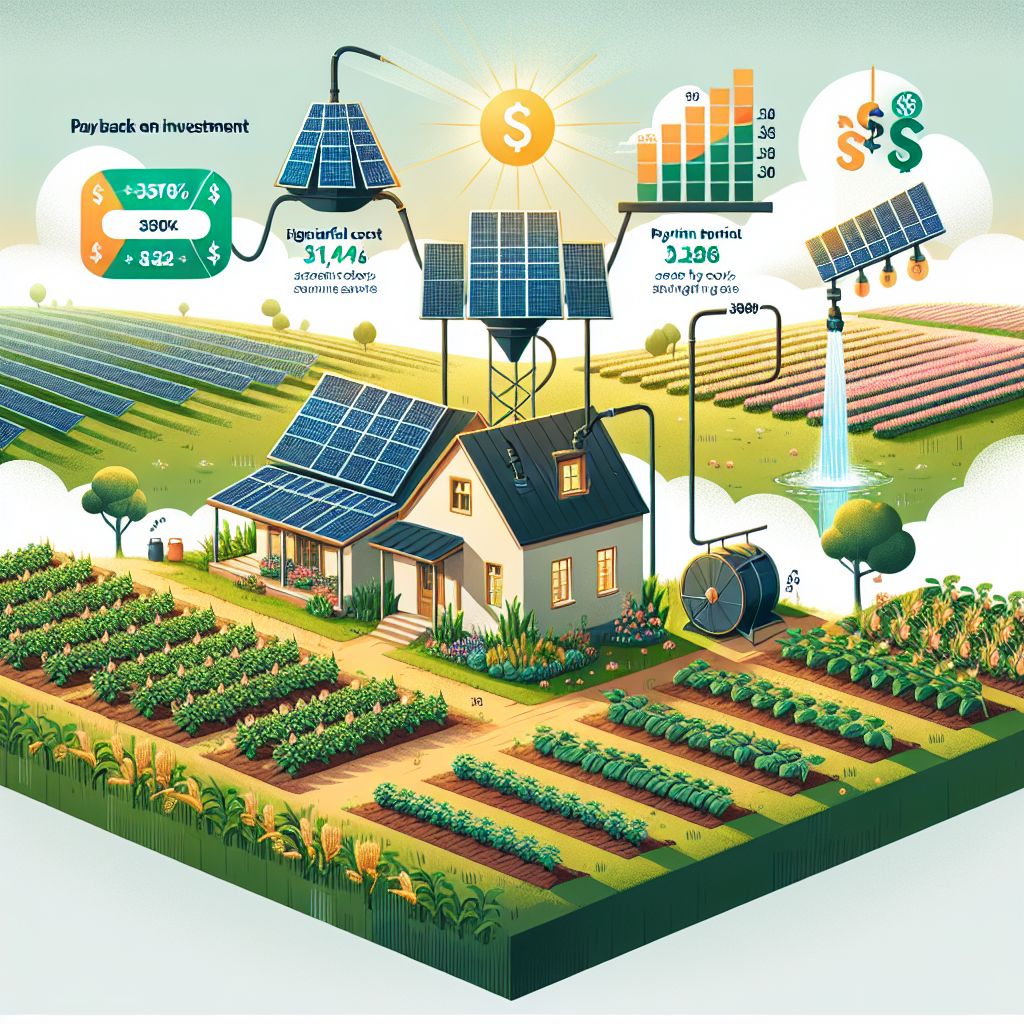
Key Takeaways
Solar irrigation on small farms can lead to significant fuel cost savings, often averaging around $394 per hectare per year.
The initial investment for solar irrigation includes the cost of solar panels, pumps, and installation, but long-term benefits often outweigh these expenses.
With proper implementation, solar irrigation systems can offer returns on investment of up to 315%, with a payback period as low as 2.88 years on average.
Grants and subsidies are available in many regions to help offset the initial costs of transitioning to solar irrigation systems.
Solar irrigation not only aids in economic sustainability for small-scale farms but also contributes positively to environmental conservation.
Utilizing the Sun’s Energy for Small-Scale Farming
As we face increasing pressures on our natural resources, every drop of water and every beam of sunlight counts. For those tending to the earth on a smaller scale, each decision is crucial for survival and success. That’s why solar irrigation is not just a buzzword; it’s a game-changer. It’s a way to bring together the power of the sun and the nurturing of crops, creating a symphony of sustainability and efficiency.
Defining Small-Scale Farming
Before we delve into the details of solar irrigation, it’s important to define what we mean by ‘small-scale farm.’ These are parcels of land that typically span up to 10 hectares, but are often much smaller. They are generally family-owned and operated, and rely on manual labor rather than large machinery. This is the type of place where every seed and every drop of water counts. In this setting, making the most of resources isn’t just a good idea—it’s vital for the farm’s survival.
The Economic Impact of Small Farmers Switching to Solar
Adopting solar irrigation means moving away from conventional, fuel-reliant methods. For small farmers, the economic implications are significant. It’s not just about being environmentally friendly; it’s about being economically savvy. Investing in solar power for irrigation could mean saying goodbye to the ongoing costs of diesel fuel. It’s about ensuring a future where the sun’s energy, a reliable daily presence, fuels your growth.
Financial Snapshot of Solar Irrigation: A Brief Overview
Let’s dive into the numbers, because they paint a powerful picture. When you switch to solar irrigation, you’re looking at fuel cost savings that can really accumulate. Imagine saving around $394 per hectare annually. Now, multiply that by the size of your farm. That’s money back in your pocket, year after year. And let’s not forget the potential for a 315% return on your investment. With numbers like that, solar irrigation isn’t just a smart choice—it’s a financially intelligent one.
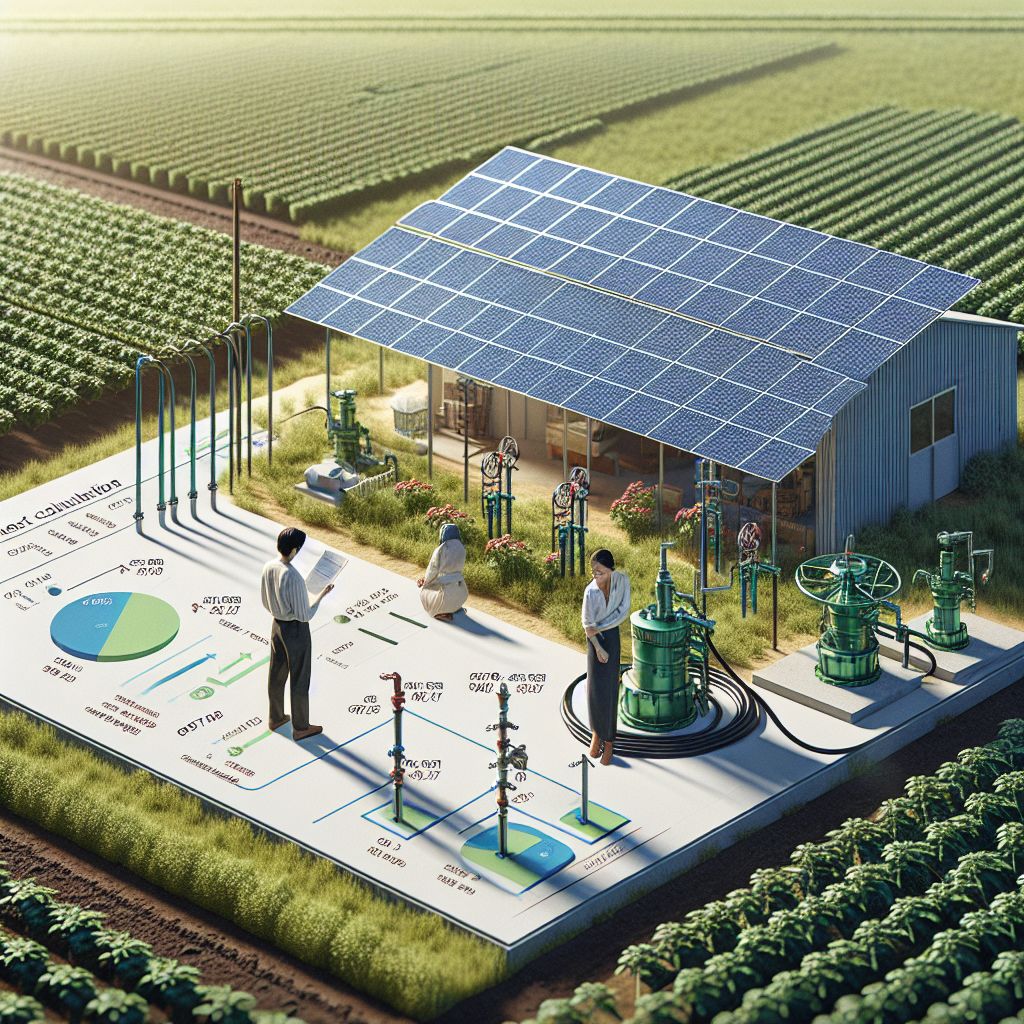
Deciphering Solar Irrigation Expenses for Small Farms
Initial expenses include solar panels, pumps, and installation.
Continuing costs are minimal, usually just maintenance and occasional parts replacements.
Many areas provide financial help in the form of grants or subsidies to aid the transition to solar power.
While it’s true that there are some initial costs associated with solar irrigation, it’s important to view this as a long-term investment that will pay for itself over time. Plus, using solar power means you’re not subject to the unpredictable nature of fuel prices. With the sun as your power source, you’re no longer at the whim of the market.
Initial Costs: Is It Worth It for a Small Farm?
Let’s unpack this. The initial cost for a solar irrigation system involves the price of solar panels, the pump, and the installation. This can range significantly based on the size of your farm and your unique needs. But, the silver lining is that this is a one-time cost with a long lifespan. Solar panels, for example, can last for 25 years or more. Therefore, while the initial cost might appear high, it’s a gift that keeps on giving.
Recurring Costs: Powering the System
Once the initial installation is complete, the recurring costs are quite low. These might include maintenance expenses, possible labor costs, and the occasional replacement part. This is a significant difference from the constant need to purchase fuel for conventional irrigation systems. With solar, once you have the system installed, the energy from the sun is free, and the savings continue to accumulate.
Here is a table summarizing the key points about deciphering solar irrigation expenses for small farms:
|
Expense Type |
Details |
|---|---|
|
Initial Expenses |
– Solar panels: $1 to $4.5 per watt-peak (Wp), with larger projects having lower costs due to economies of scale. 3 |
|
Ongoing Costs |
– Maintenance: Estimated at $80/kW to $300/kW per year. 3 |
|
Financial Incentives |
– Government and utility programs offering loans, grants, and tax credits to offset initial costs. 1, 2, 3 |
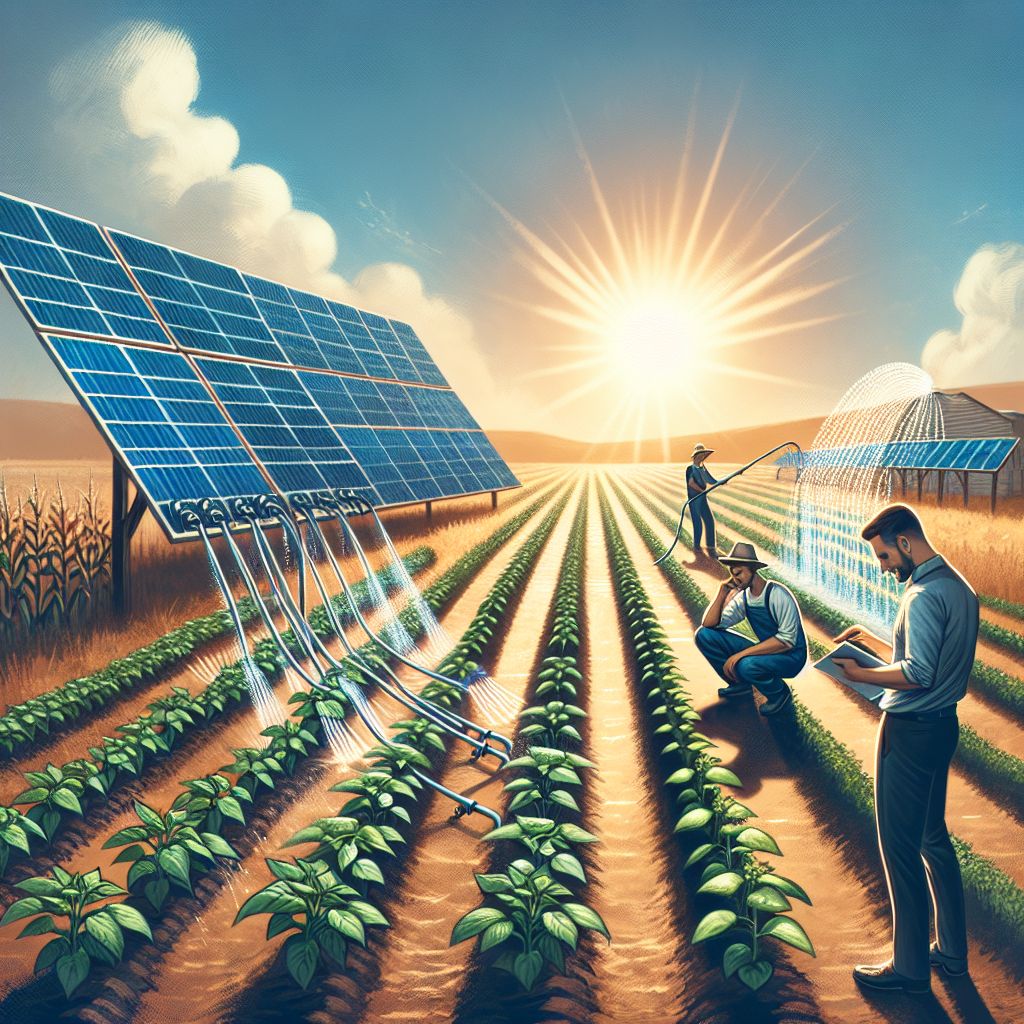
Evaluating the Economic Benefits of Using Solar Irrigation on A Small Farm
Utilizing sunlight as a resource to boost crop yields can have significant economic benefits for small-scale farmers. With the use of greenhouses and crop rotation, farmers can not only increase their overall crop yield but also reduce input costs and long-term savings. As the demand for sustainable and environmentally-friendly farming practices increases, utilizing sunlight to boost crop yields is a promising solution for small-scale farmers to improve their financial stability.
Increasing Crop Production with Solar Power
Solar irrigation isn’t just about reducing costs; it’s also about the possibility of increasing crop yields. Solar irrigation can provide a steady water supply that isn’t dependent on the availability or cost of fuel. This allows you to water your crops exactly when they need it, which is critical for getting the most yield. More water when it’s needed means healthier, happier plants and, as a result, more produce to sell at the market.
Regular and timely watering can result in healthier plants and increased yields.
Solar watering systems can be programmed for the best watering times, reducing water waste.
The dependability of solar energy means fewer disruptions in the watering schedule.
Consider the relief of knowing that your watering system is working with the sun, day after day, to nurture your plants. This isn’t just about machinery; it’s about working with the environment to create a symphony of growth. By using the sun’s power, you’re able to provide a consistent, reliable source of water, and that’s a big deal for the health of your plants.
Here’s a fun fact: research indicates that crops that receive regular irrigation are less stressed and healthier. This can result in better-quality produce, which can fetch a higher price. So, you’re not just saving money on fuel, you’re also potentially making more from your harvest.
How Solar Irrigation Can Save Money in the Long Run for Small Farms
If you plan to be in farming for the long run, it’s important to think about the future. Investing in solar irrigation can lead to significant long-term savings. With no fuel costs and low maintenance requirements, the system can pay for itself over time. Plus, with fuel prices becoming more and more unpredictable, solar offers a stable alternative that can help protect your bottom line.
Furthermore, the cost of solar panels and equipment has been on a consistent downward trend, making them more affordable than ever before. When you also consider the possibility of government subsidies or grants, the financial prospects look even more promising. This presents a strong argument for transitioning to solar sooner rather than later.
Moreover, with the continuous progress in solar technology, we can anticipate higher efficiency and more savings. The sun is a resource that’s not going to disappear anytime soon, and harnessing this renewable energy source is a wise economic decision for any small farmer.
“Ever since we switched to solar irrigation, our water costs have been practically nonexistent. It’s amazing to see how much we’ve saved and how quickly the system has paid for itself.” – A small-scale farmer who made the switch to solar irrigation.
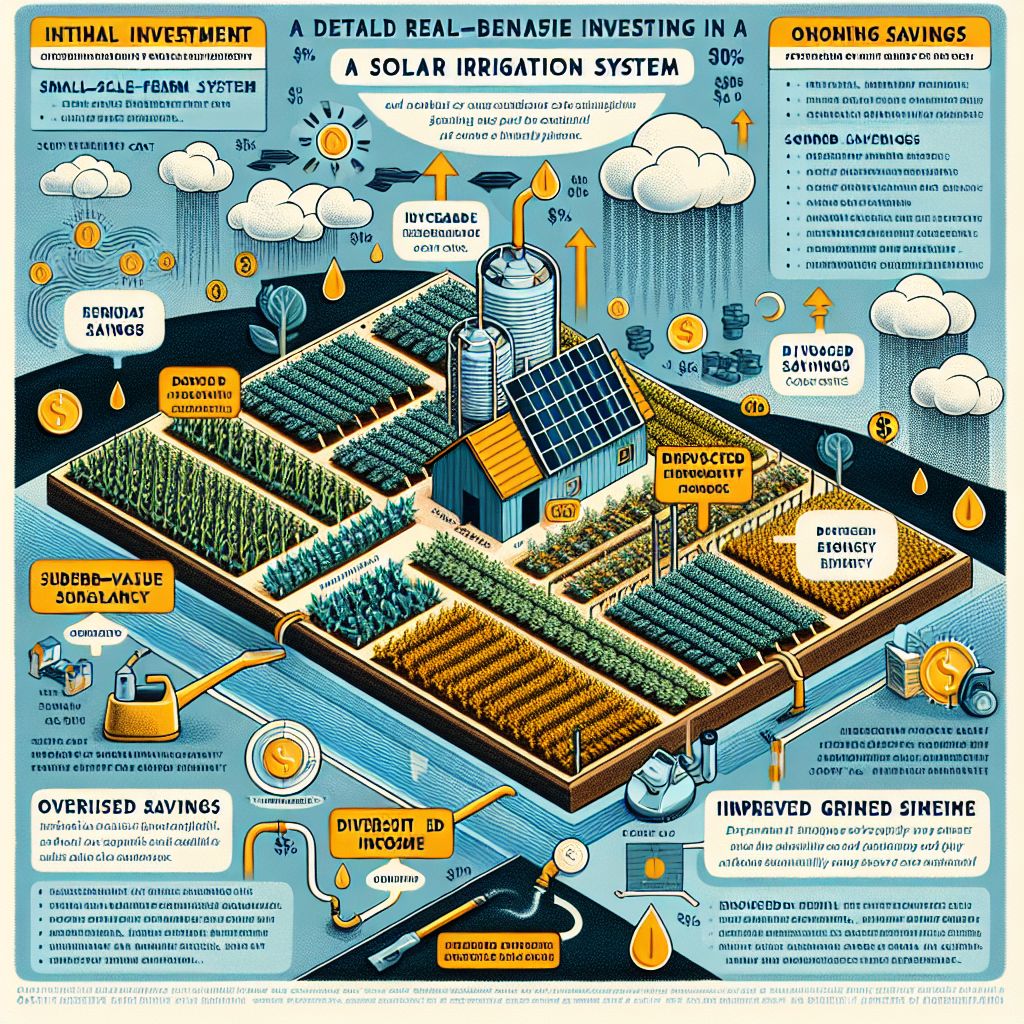
The Real Cost-Benefit Analysis of a Small-Scale Farm
Let’s discuss the real cost-benefit analysis. We’ve talked about the initial costs and the continuous savings, but what does this mean for you as a small-scale farmer? It means that, by investing in solar irrigation, you’re establishing a system that not only lowers your operating costs but also raises your farm’s value. You’re incorporating resilience into your business model and ensuring that your farm can prosper despite economic and environmental challenges.
Here is a table summarizing the real cost-benefit analysis of a small-scale farm investing in a solar irrigation system:
|
Cost-Benefit Factor |
Details |
|---|---|
|
Initial Investment |
– Solar panels, pumps, and installation can cost $10,000 or more upfront. 1, 3 |
|
Ongoing Savings |
– Elimination of energy costs for grid electricity, diesel, or gasoline to power irrigation pumps. 1, 2, 3 |
|
Increased Yields |
– Reliable year-round irrigation allows for higher-yielding crops and multiple growing seasons. 1, 2, 3 |
|
Diversified Income |
– Surplus electricity generated can be sold back to the grid or used to power other farm operations. 1, 3 |
|
Improved Resilience |
– Solar irrigation systems are less vulnerable to grid outages or fuel shortages. 2, 4 |
|
Return on Investment |
– With financial incentives, the system can pay for itself in as little as 5 years through energy savings and increased profits. 1, 3 |
Crunching the Numbers: Long-Term Solar Savings
It’s not difficult to figure out the return on investment for solar irrigation. Start with the initial installation cost, then subtract the yearly savings on water and fuel. As the years go by, those savings add up. Eventually, they exceed the initial cost. The result is pure profit, all thanks to the sun. Plus, using solar doesn’t just save you money. It also helps the planet by cutting down on carbon emissions.
We should point out that the return on investment isn’t simply a matter of dollars and cents. There’s also the return on investment for the environment and your peace of mind. These aren’t as easy to measure but are priceless in today’s world.
When Will Small Farmers Start Making Money?
The payback period is how long it takes for the savings from your solar irrigation system to pay for the initial costs. On average, small farmers start making money after about 2.88 years. But this number can change depending on several factors, like how big your farm is, how much the system costs, and how much you’re currently spending on fuel for irrigation.
After you reach the payback period, every penny you save is a penny earned. Given the durability of solar systems, you could be looking at years, if not decades, of free irrigation once the system is paid off.
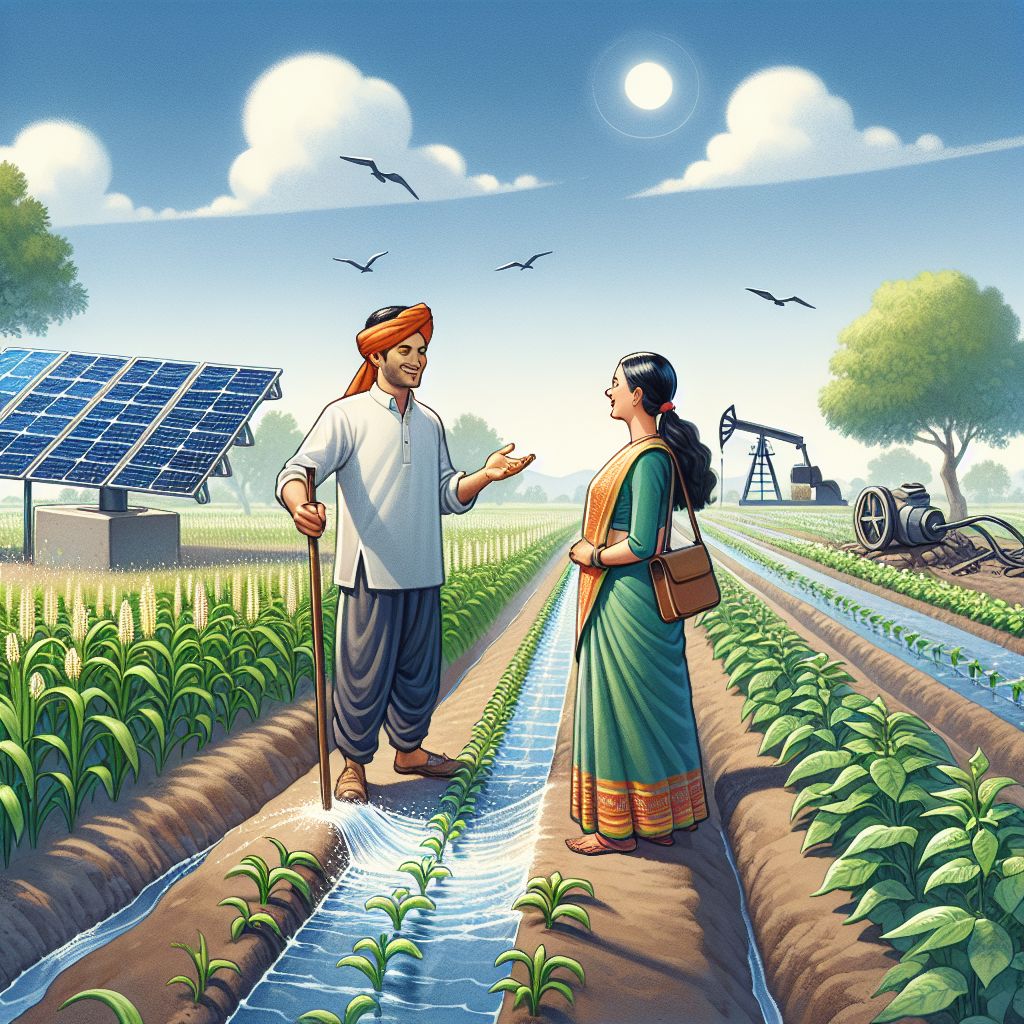
Practical Results: Key Points from Case Studies
Nothing illustrates the effect of solar irrigation on small-scale farming better than real-life examples. There are many stories of farmers who have revolutionized their farming methods by adopting this technology. These stories are not just motivational, but they are also solid proof of the advantages of solar irrigation.
Success Stories: Farmers Thriving with Solar
Consider, for instance, a small farmer from a developing country who used to depend on unpredictable rainfall and expensive diesel pumps for irrigation. After converting to solar, they reported not only a significant decrease in water expenses but also an increase in crop yields due to the more dependable water source. This is just one of many instances where solar irrigation has made a measurable impact on a farmer’s life.
Another triumphant tale hails from a farmer who managed to extend their planting season due to the dependable water source provided by solar irrigation. They were no longer restricted by the seasons or the cost of fuel, and they were able to plant more crops all year round, resulting in higher earnings and a more sustainable business.
What We’ve Learned: Problems and Solutions
Switching to solar irrigation isn’t without its difficulties. Some farmers may be hesitant at first because of the initial costs or because they don’t fully understand the advantages. Some may find the technical aspects of setting up and maintaining a solar irrigation system to be daunting.
However, the solution to these issues is in education and support. By equipping farmers with the necessary knowledge and resources, we can assist them in overcoming these obstacles and harness the full benefits of solar irrigation. After all, knowledge is power, and in this case, it’s the power to revolutionize our farming practices for the better.
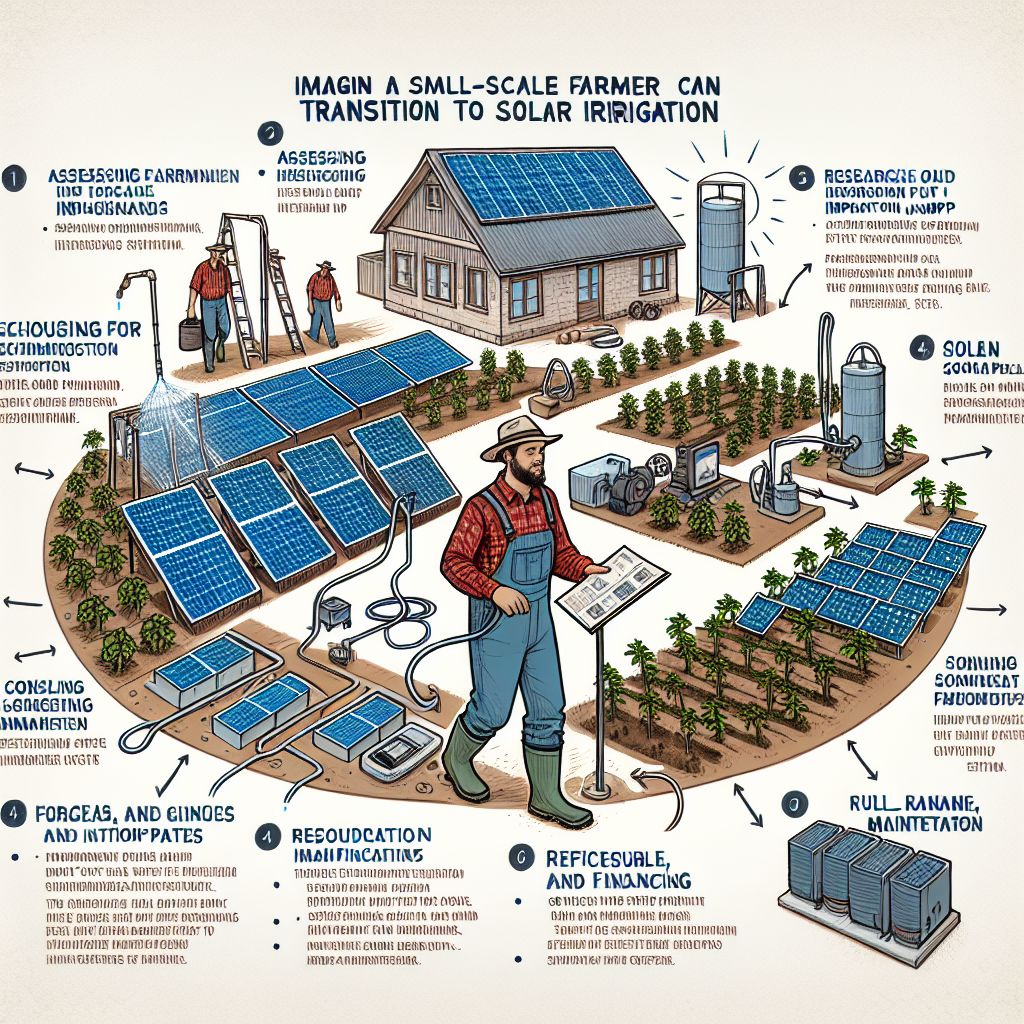
How to Get Started
If you’re a small farmer looking to transition to solar irrigation, the first thing you need to do is to get informed and come up with a game plan. This means understanding what your specific needs are, researching the different solar irrigation systems on the market, and finding out if there are any financial aid options available to you.
Then, it’s important to reach out to professionals and other farmers who have already switched. They can give you useful tips and guidance to help you steer clear of frequent mistakes and guarantee a seamless implementation process.
Lastly, it’s okay to start small. You don’t need to switch your entire irrigation system to solar in one go. Start with a small solar irrigation project to get a feel for the technology and slowly expand as you get more used to it.
By adopting these methods and harnessing the energy of the sun, you can guide your farm towards increased sustainability and financial stability. For those who decide to implement solar irrigation, the future certainly looks bright.
How to Build a Solar Setup: A Step-by-Step Guide
Understand your farm’s irrigation requirements and the amount of sunlight it receives.
Investigate and choose suitable solar panels and an irrigation pump.
Seek professional advice for system design and installation.
If necessary, arrange for financing and look for any available grants or subsidies.
Install and thoroughly test the system.
Regularly maintain the system to ensure it performs at its best.
If you’re a small-scale farmer and you’re considering switching to solar irrigation, here’s a step-by-step guide to help you get started. Start by figuring out what your irrigation needs are. How much water do your crops need? When do they need it? Then, look at the sky—how much sunlight does your farm get? This will help you figure out what size and type of solar panels you’ll need.
After you have a solid understanding of the basics, it’s time to get into the nitty-gritty. You must choose a solar pump that is strong enough to handle your irrigation needs but not so strong that it consumes unnecessary energy. A little bit of research and expert advice can make a big difference here.
When it comes to installation, unless you’re particularly handy and have experience with solar systems, it’s best to leave this to the professionals. They’ll ensure your system is designed efficiently and installed safely. This is an investment in your farm’s future, so you want it done right.
Keep in mind the economic aspect. You may find grants, subsidies, or financing options that can help cover the cost of your new solar irrigation system. Use these opportunities to make the switch more cost-effective.
Once your setup is in place, it’s important to run a comprehensive test to make sure everything is working as it should. Like all the other machinery on your farm, your solar irrigation system will require routine care to keep it running at peak performance.
Right Below is a table with a step-by-step guide for a small-scale farmer considering switching to a solar irrigation system:
|
Step |
Details |
|---|---|
|
1. Assess Your Water Needs |
– Determine the water requirements for your crops and land size. 3, 4 |
|
2. Evaluate Your Solar Potential |
– Assess the solar irradiation levels and availability of sunlight at your farm location. 3, 5 |
|
3. Select the Right Equipment |
– Choose solar panels with high efficiency and durability to meet your energy needs. 3 |
|
4. Explore Financing Options |
– Research available government grants, subsidies, or low-interest loans to offset the initial investment. 1, 2, 3 |
|
5. Install and Maintain the System |
– Work with a qualified installer to ensure proper system design and integration. 3 |
|
6. Integrate with Sustainable Practices |
– Implement water conservation techniques, such as drip irrigation or precision farming, to maximize the benefits of solar irrigation. 4, 5 |
By following this step-by-step guide, small-scale farmers can make an informed decision and successfully transition to a solar irrigation system, unlocking the economic and environmental benefits it can provide.
Conclusion:
Wrapping it all up, solar irrigation is a sustainable and economically viable solution for small-scale farmers. By harnessing the sun’s power, you can lower operating costs, boost crop yields, and contribute to a greener environment. While the initial investment may be substantial, the long-term benefits and potential savings make it a smart choice for those looking to future-proof their farming operations.
Frequently Asked Questions
How does a solar irrigation system work on a small farm?
Solar irrigation systems operate by utilizing photovoltaic panels to harness solar energy. This energy is then converted to power a pump that moves water from a source to the crops. The systems can be adapted to meet the unique needs of a small farm and can be configured to offer a steady and reliable water source for irrigation.
What are the startup costs for a solar irrigation system?
The startup costs for a solar irrigation system can range widely depending on the size of the system and the specific needs of the farm. On average, small-scale farmers may need to invest anywhere from a few thousand to several thousand dollars, which includes the cost of solar panels, the pump, installation, and any other necessary equipment for the system.
How long does it take for a solar irrigation system to pay for itself?
On average, a solar irrigation system will pay for itself in about 2.88 years. This can fluctuate depending on things like how much the system cost, how big the farm is, and how much sunlight the area gets. After this time, the money saved on water and fuel starts to become a profit.
Cost to invest: This will vary, but it can be balanced out by the savings and subsidies you might receive.
Return on investment period: On average, this is about 2.88 years.
Money saved: Over time, you will see significant savings, especially in fuel and water costs.
Can I get government subsidies to help with the cost of solar irrigation?
Yes, many governments and organizations offer subsidies and grants to help with the cost of solar irrigation systems. These financial incentives can help balance out the initial cost of installation and make it more affordable for small-scale farmers. It’s important to look into what’s available in your specific area.
Subsidies are frequently designed to promote sustainable farming methods and can greatly alleviate the financial strain of transitioning to solar energy. Farmers who utilize these programs can invest in their long-term prosperity and sustainability.
Is it possible to use solar irrigation systems in areas with less sunlight?
Yes, solar irrigation systems can work in areas with less sunlight, although it might require more planning and investment. For instance, farmers in areas with less sunlight might need to install more panels or use batteries to store energy for use during cloudy periods or at night.
Despite this, solar panels are evolving and becoming more effective at converting sunlight into energy, even in challenging conditions. As a result, solar irrigation continues to be a feasible option for most areas, as long as the system is tailored to the local weather.







Leave a Reply